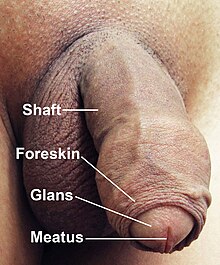
Back Pintel ANG قضيب الإنسان Arabic قضيب ديال بنادم ARY قضيب الراجل ARZ মানৱ উপস্থ Assamese İnsan penisi Azerbaijani Ир енес ағзаһы Bashkir Buto nin tawo BCL Пеніс чалавека Byelorussian Чэлес BE-X-OLD
| Human penis | |
|---|---|
 A flaccid uncircumcised penis; naturally occurring pubic hair has been deliberately removed to show anatomical detail | |
| Details | |
| Precursor | Genital tubercle, urogenital folds, urogenital sinus |
| System | Genitourinary system, male reproductive system |
| Artery | Dorsal artery of the penis, deep artery of the penis, artery of bulb, internal pudendal artery |
| Vein | Deep dorsal vein, superficial dorsal vein of the penis, vein of bulb, internal pudendal veins |
| Nerve | Dorsal nerve of the penis, pudendal nerve |
| Lymph | Superficial inguinal lymph nodes |
| Identifiers | |
| Latin | penis, pudendum virile, membrum virile |
| MeSH | D010413 |
| TA98 | A09.4.01.001 |
| TA2 | 3662 |
| FMA | 9707 |
| Anatomical terminology | |
In human anatomy, the penis (/ˈpiːnɪs/; pl.: penises or penes; from the Latin pēnis, initially "tail"[1]) is an external male sex organ (intromittent organ) that additionally serves as the urinary duct. The main parts are the root, body, the epithelium of the penis including the shaft skin, and the foreskin covering the glans. The body of the penis is made up of three columns of tissue: two corpora cavernosa on the dorsal side and corpus spongiosum between them on the ventral side. The urethra passes through the prostate gland, where it is joined by the ejaculatory duct, and then through the penis. The urethra goes across the corpus spongiosum and ends at the tip of the glans as the opening, the urinary meatus. It is a passage both for excretion of urine and the ejaculation of semen.
An erection is the stiffening expansion and orthogonal reorientation of the penis, which occurs during sexual arousal. Erections can occur in non-sexual situations; spontaneous non-sexual erections frequently occur during adolescence and sleep. In its flaccid state, the penis is smaller, gives to pressure, and the glans is covered by the foreskin. In its fully erect state, the shaft becomes rigid and the glans becomes engorged but not rigid. An erect penis may be straight or curved and may point at an upward angle, a downward angle, or straight ahead. As of 2015[update], the average erect human penis is 13.12 cm (5.17 in) long and has a circumference of 11.66 cm (4.59 in).[2][3] Neither age nor size of the flaccid penis accurately predicts erectile length. There are several common body modifications to the penis, including circumcision and piercings.
The penis is homologous to the clitoris in females.[4]
- ^ Harper, Douglas. "penis". Online Etymology Dictionary.
- ^ Berezow, Alex B. (March 2, 2015). "Is Your Penis Normal? There's a Chart for That". RealClearScience. Archived from the original on May 24, 2020. Retrieved July 7, 2018.
- ^ Veale, D.; Miles, S.; Bramley, S.; Muir, G.; Hodsoll, J. (2015). "Am I normal? A systematic review and construction of nomograms for flaccid and erect penis length and circumference in up to 15 521 men". BJU International. 115 (6): 978–986. doi:10.1111/bju.13010. PMID 25487360. S2CID 36836535.
- ^ Tortora, Gerard J; Anagnostakos, Nicholas P (1987). Principles of anatomy and physiology (5th ed.). New York: Harper & Row. pp. 727–728. ISBN 978-0060466695.
© MMXXIII Rich X Search. We shall prevail. All rights reserved. Rich X Search